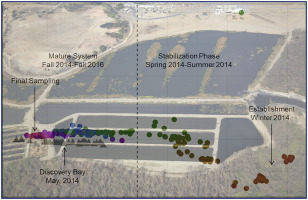Water Research ( IF 12.8 ) Pub Date : 2018-01-10 , DOI: 10.1016/j.watres.2018.01.021 Zackary L. Jones , Kristin M. Mikkelson , Scott Nygren , David L. Sedlak , Jonathan O. Sharp

|
The widespread adoption of engineered wetlands designed for water treatment is hindered by uncertainties in system reliability, resilience and management associated with coupled biological and physical processes. To better understand how shallow unit process open-water wetlands self-colonize and evolve, we analyzed the composition of the microbial community in benthic biomats from system establishment through approximately 3 years of operation. Our analysis was conducted across three parallel demonstration-scale (7500 m2) cells located within the Prado Constructed Wetlands in Southern California. They received water from the Santa Ana River (5.9 ± 0.2 mg/L NO3-N), a water body where the flow is dominated by municipal wastewater effluent from May to November. Phylogenetic inquiry and microscopy confirmed that diatoms and an associated aerobic bacterial community facilitated early colonization. After approximately nine months of operation, coinciding with late summer, an anaerobic community emerged with the capability for nitrate attenuation. Varying the hydraulic residence time (HRT) from 1 to 4 days the subsequent year resulted in modest ecological changes across the three parallel cells that were most evident in the outlet regions of the cells. The community that established at this time was comparatively stable for the remaining years of operation and converged with one that had previously formed approximately 550 km (350 miles) away in a pilot-scale (400 m2) wetland in Northern California. That system received denitrified (20.7 ± 0.7 mg/L NO3-N), secondary treated municipal wastewater for 5 years of operation. Establishment of a core microbiome between the two systems revealed a strong overlap of both aerobic and anaerobic taxa with approximately 50% of the analyzed bacterial sequences shared between the two sites. Additionally the same species of diatom, Stauirsa construens var. venter, was prolific in both systems as the putative dominant primary producer. Our results indicate that despite differences in scale, geographic location and source waters, the shallow open-water wetland design can select for a rapid convergence of microbial structure and functionality associated with the self-colonizing benthic biomat. This resulting biomat matures over the first growing season with operational parameters such as HRT further exerting a modest selective bias on community succession.
中文翻译:

浅水单元浅水湿地光合微生物菌群的建立与融合
为水处理而设计的工程湿地的广泛采用受到与生物和物理过程耦合相关的系统可靠性,适应性和管理方面不确定性的阻碍。为了更好地了解浅层单元处理开放水湿地如何自我定殖和进化,我们分析了从系统建立到运行约3年的底栖生物垫中微生物群落的组成。我们对位于南加州普拉多人工湿地内的三个平行示范规模(7500 m 2)单元进行了分析。他们从圣安娜河获得了水(5.9±0.2 mg / L NO 3-N),这是一个水体,其流量由5月到11月的市政废水排出。系统发生学调查和显微镜检查证实,硅藻和相关的有氧细菌群落促进了早期定殖。经过大约九个月的运行,恰逢夏末,出现了具有减少硝酸盐能力的厌氧菌群。第二年将水力停留时间(HRT)从1天更改为4天,导致三个平行电池的温和生态变化适中,这在电池出口区域最为明显。此时建立的社区在剩余的运营年中相对稳定,并与先前形成约550公里(350英里)的试点规模(400 m 2)的社区融合。)北加州的湿地。该系统在运行5年后接受了脱硝(20.7±0.7 mg / L NO 3 -N)二次处理的市政废水。在两个系统之间建立了一个核心微生物组,揭示了有氧和厌氧类群之间有很强的重叠性,两个位置之间共有大约50%的被分析细菌序列。此外,相同种类的硅藻Stauirsa construens var。腹部,在两个系统中均是多产的假定主要主导生产者。我们的结果表明,尽管规模,地理位置和水源水有所不同,但浅水开阔湿地设计仍可以选择与自殖民底栖生物垫相关的微生物结构和功能的快速收敛。这种产生的生物垫在第一个生长季节成熟,其操作参数(例如HRT)进一步对群落演替产生了适度的选择性偏见。



























 京公网安备 11010802027423号
京公网安备 11010802027423号